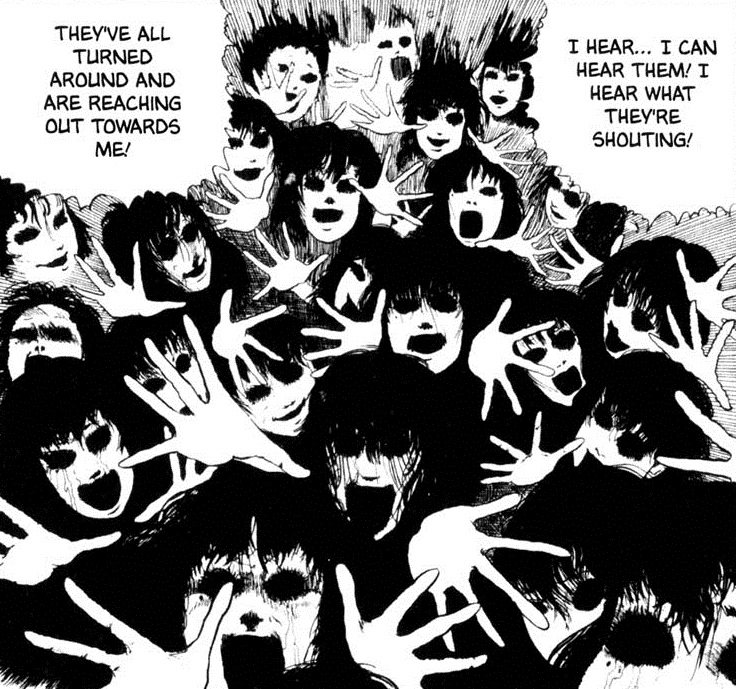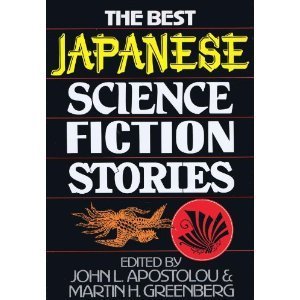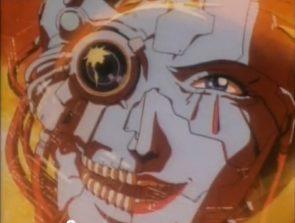 The Museum of Terror books are collections of Junji Ito’s early manga stories. In 2006, English readers lucked out when Dark Horse started releasing them in English. Unfortunately, the series was cancelled at volume 3 due to lack of sales. Lesson learned: manga fans are the most dedicated and passionate fans on Earth…unless you want to earn money from them. Then you starve to death.
The Museum of Terror books are collections of Junji Ito’s early manga stories. In 2006, English readers lucked out when Dark Horse started releasing them in English. Unfortunately, the series was cancelled at volume 3 due to lack of sales. Lesson learned: manga fans are the most dedicated and passionate fans on Earth…unless you want to earn money from them. Then you starve to death.
The first volume is all about Tomie, who is Ito’s most famous character…a girl who inspires madness and obsession in the men around her, to the point where they try to kill her. They often succeed. But it soon becomes clear that Tomie is not even close to human, and she always comes back.
Apparently she was inspired by an event from Ito’s childhood, when a classmate died in an accident and he wondered how people would react if she showed at up school the next day. The nine 30-40 page stories all hit a similar riff: Tomie appears, guys fall in love with her, guys kill her, and she is reborn.
The Tomie formula soon becomes very familiar…even overfamiliar. Honestly, these are far from Junji Ito’s best works. Tomie launched Ito’s career and paved the way for a lot of great manga, but set against his later material they seem fairly tame and unremarkable. Ito imagination is nearly limitless, and Tomie constrains him.
How so? There’s no sense of mystery about Tomie. We know what her powers are, and what her personality is like, and the effect she has on people around her. We know everything about her, and that’s boring. The crazy off-the-rails madness of Uzumaki makes Tomie look suspiciously like a Dead Teenager movie, where we know all the beats it’s going to hit, and the only question is whether Jennifer Love Hewitt or Sarah Michelle Gellar will survive for the sequel.
…But of course, another difference between Uzumaki and Tomie is that Tomie is creepy undead moe-ish girl and is thus hugely marketable With nine movie adaptations of Tomie to date, Ito’s humble creation has become a horror franchise, questions of quality aside.
Out of these nine stories “Painter” is by the far the best, mostly because of its powerful Gothic atmosphere. All of these stories are violent and intense but some of them are a bit lacklustre in execution, either because of poor art (some of these are Ito’s very first stories) or lackluster plot or execution. “Revenge” is dull, just an uninspired retread of other ideas in the manga. “Mansion” is overkill in the other direction. Ito tried way too hard with this one, it’s one unbelievable and over-the-top plot development after another until eventually I gave up caring.
Yet at the core of the Tomie mythos there is a powerful idea. The stories lean pretty heavily on gore and shocking imagery, but ultimately they’re not about that. They’re not even about Tomie! These stories are about obsession, and how quickly we can slide from being rational human beings to automatons of our primal urges. Tomie might not be interesting. But the insane, obsessed males around her are actually fairly frightening.

This book is superb. English readers will be either introduced to or reminded of Japanese sci-fi legends like Kobo Abe, Sakyo Komatsu, and Shinichi Hoshi. Calling these thirteen stories “science fiction” is a little like calling Watchmen a superhero story: correct, but they do other things besides. They are fantastic and surprising tales that attack the dendrites from various angles: comedy, horror, and raw surrealist speculation.
Kobo Abe’s “The Flood” is the psychotic tale of a class uprising beyond the dreams of Marx. Poor folk are literally turning into water and murdering their overlords by drowning them. With the planet rapidly becoming flooded with transformed proletariat, Noah (yes, that Noah) attempts to rebuild the ark and save the human race.
Ryo Hanmura’s “Cardboard Box” depicts the world as seen by a cardboard box. The only goal of a box is to be full, and we experience some of the box’s misery as it is sold and its contents (oranges, if I recall correctly) are removed, one by one, until it’s empty. Is there a happy ending for the box? Like “Animal Farm,” this story finds a balance between the comical and the serious.
“Tansu” by the same author manages to be rather frightening. A man’s family is possessed by a strange neurosis that nobody can understand, and eventually he is caught up in it. The ending explains nothing and everything.
“Bokko-chan” by Shinichi Hoshi is amusing but leaves the reader with a heavy heart. A mechanically-inclined barkeep builds an attractive android girl to help attract custom. Most of his regulars figure out she’s not real, but a deluded young man actually falls in love with her, mistakes her pre-programmed responses for expressions of love, and so on. This story seems the most prescient in the internet age: it’s fits current topics like parasocial relationships and so on.
Shinichi Hoshii’s “He-y, Come on Ou-t!” is about townsfolk who find a bottomless hole. Soon the hole becomes a popular dumping ground for garbage. Partway through I had an inkling of where the story was going, but the ending still made me say “oh, shit.” Out loud.
Takashi Ishikawa’s “The Road to the Sea” is another story in the same vein, an interesting story with a gigantic whiplash of an ending. A boy is possessed by a burning hunger to see the ocean, and goes on a ill-fated journey to find it. Another twist ending, this one harder to see.
“The Empty Field” by Morio Kita is twelve pages of experimental prose. Weird, but okay.
Sakyo Komatsu’s “The Savage Mouth” is a gruesome nightmare about a man who eats his own body, piece by piece. Kind of like Stephen King’s “Survivor Type”, except where King flinches and ends his story, Komatsu keeps going and going. The final pages carry an interesting sociological edge.
Komatsu’s “Take Your Choice” is less disturbing but equally thought provoking. A man has been offered a once-in-a-lifetime chance to escape into the future. Except he’s not really going to the future, he’s going to an alternate present, which then (he’s told) will become his chosen future. Some really thought provoking ideas in one of the volume’s standout stories.
“Triceratops” by Tensei Kono features a man and a boy who can somehow see dinosaurs walking around their 20th century town. Nobody else can see a thing. I don’t know if Kono was a fan of American TV shows, but it reads like a novelized The Twilight Zone or The Outer Limits.
“Fnifmum” by Taku Mayumura is about an alien lifeform which moves around in time the way we move around in space. More a world-building exercise than a story, but it’s unique and memorable. Mayumura has shown us a creature that is as alien as an alien can be, and still makes us relate to it.
Yasutaka Tsutsui’s “Standing Woman” is an Orwell-inspired story about a futuristic society that has found a disturbing method for greening its public places: criminals are literally turned into human tree. The story is told from the perspective of a pandering, spineless writer who is disgusted by how he isn’t standing up against the oppression. His own wife has become a tree, and his inner torment is portrayed brilliantly.
The final story is “The Legend of the Paper Spaceship” by Tetsu Yano. On the surface, it’s about a remote village that is home to a mentally retarded woman who never seems to age. What it’s really about is uneasy passage of lore, and the impossibility of untangling a skein of mysteries that happened many years ago and to people who are dead. Plot fragments are brought up, touched upon, and then we lose sight of them again in the dense world Yano has created. I have read this story several times and I believe I have figured out at least 65% of it.
So no, science fiction isn’t the term. They are works of imagination, sometimes the imaginations involved are highly esoteric. Western science fiction is about the stars. These stories are about a place equally incomprehensible and interesting: within.

There’s a lot to like about Genocyber. It’s edgy, it’s violent, and it has a great atmosphere. But like so many OVAs, the weight is all in the packaging. Any dissection or analysis of this anime reveals there’s really not a lot at its center.
The plot looks deep and engaging at first, but almost immediately you realise it’s a ripoff of a ripoff of a ripoff. Blah blah siblings with a psychic link blah blah huge robot mechas blah blah shadowy government agents blah blah climactic transformation scene blah blah city blows up the end. The characters are mostly just stock, including the usual assortment of evil scientists and masked henchmen and a gang of street thugs lifted right out of Akira.
If you don’t care much about story, Genocyber works. It evokes a nasty and brutal atmosphere, and the thematic confusion could be interpreted as acute psychological depth. It worked for Neon Genesis Evangelion, after all. The animation is punchy and colourful, with a few CGI moments mixed in here and there. On the whole it’s hard not to be impressed by Genocyber‘s aesthetics and style, even if the content side of the anime comes up short. As with Ohata Koichi’s previous work MD Geist, the gore factor is comically high. One scene in the middle gets so outrageous and excessive that it borders on being comedic. The final battle ends with all of Hong Kong destroyed.
Things get hard to follow. Genocyber is confusing, bombastic, and over-the-top. In a way, it’s almost like its own characters, in that it’s cataclysmically fucked in the head and deserves to be in a room with padded walls. This is a definitive example of 90s anime, both the good and bad. The English dubbing sucks ass, by the way.
 The Museum of Terror books are collections of Junji Ito’s early manga stories. In 2006, English readers lucked out when Dark Horse started releasing them in English. Unfortunately, the series was cancelled at volume 3 due to lack of sales. Lesson learned: manga fans are the most dedicated and passionate fans on Earth…unless you want to earn money from them. Then you starve to death.
The Museum of Terror books are collections of Junji Ito’s early manga stories. In 2006, English readers lucked out when Dark Horse started releasing them in English. Unfortunately, the series was cancelled at volume 3 due to lack of sales. Lesson learned: manga fans are the most dedicated and passionate fans on Earth…unless you want to earn money from them. Then you starve to death.

